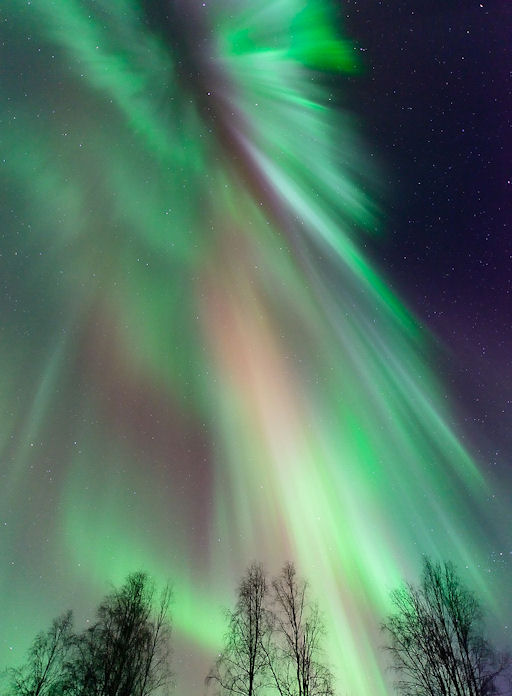AURORAS LOVE EQUINOXES: The seasons are changing. Today, March 20th, the sun is crossing cross the celestial equator heading north. This marks the beginning of spring in the northern hemisphere and autumn in the southern hemisphere. At this time of year, day and night are of nearly equal length, hence the name "equinox" (equal night).
For reasons researchers don't fully understand, auroras love equinoxes. During the weeks around the beginning of spring or fall, the slightest gust of solar wind can provoke bright lights around the poles. A potent CME impact at this time can produce an unforgettable display, like this one only a few days ago:
"I took this photo during the historic St. Patrick's Day geomagnetic storm of 2013," says Ben Hattenbach of Fairbanks, Alaska. "I'm still exhausted from the experience, during which the aurora was at or near peak strength for the entire night. It was just incredible in a way pictures cannot come close to conveying."
With the beginning of northern spring, the stage is set for more auroras tonight. NOAA forecasters estimate a 20% - 30% chance of polar geomagnetic storms on March 20-21. Aurora alerts: text, voice.
COMET DODGES CMEs: NASA's STEREO-B spacecraft has been monitoring Comet Pan-STARRS, taking hundreds of pictures as the comet passed by the sun this month. Yesterday, analyst Karl Battams of the Naval Research Lab assembled the data into a single movie spanning eight days, from March 9th through 16th. Click to set the scene in motion:
STEREO-B is stationed over the farside of the sun, so cameras onboard the spacecraft can look back and see Earth as well as the comet. In Battams' movie, the sun is located just outside the field of view on the left. Massive clouds of magnetized plasma (CMEs) billow away from the sun toward the comet, but according to Battams, none hit their mark:
"There were two CMEs in that sequence and it seems they went either side of the comet," he says. "That's a shame for us scientists because we would like to study how CMEs interact with a comet."
CMEs have been known to rip the tails off comets that pass too close to the sun, but that did not happen to Comet Pan-STARRS.
"By the way," adds Battams, "I've looked closely at the STEREO images and can see no indication of the possible fragment recently reported on spaceweather.com. I also haven't noticed any unusual brightening or disruption in the comet tail that would hint at such a fragmentation event having occurred."
More: NASA video, 3D orbit, ephemeris, light curves.

![]()
Solar wind
speed: 465.1 km/sec
density: 0.5 protons/cm3
explanation | more data
Updated: Today at 1627 UT
![]()
X-ray Solar Flares
6-hr max: B6 1016 UT Mar20
24-hr: C5 0103 UT Mar20
explanation | more data
Updated: Today at: 1600 UT
![]()
![]()
![]()
Daily Sun: 20 Mar 13
![]()
![]()
Solar activity is low. None of these sunspots poses a threat for strong flares. Credit: SDO/HMI
![]()
![]()
![]()
Sunspot number: 68
What is the sunspot number?
Updated 20 Mar 2013
Spotless Days
Current Stretch: 0 days
2013 total: 0 days (0%)
2012 total: 0 days (0%)
2011 total: 2 days (<1%)
2010 total: 51 days (14%)
2009 total: 260 days (71%)
Since 2004: 821 days
Typical Solar Min: 486 days
Update 20 Mar 2013
The Radio Sun
10.7 cm flux: 110 sfu
explanation | more data
Updated 20 Mar 2013
![]()
![]()
![]()
Current Auroral Oval:
![]()
Switch to: Europe, USA, New Zealand, Antarctica
Credit: NOAA/POES
![]()
![]()
![]()
Planetary K-index
Now: Kp= 2 quiet
24-hr max: Kp= 2 quiet
explanation | more data
![]()
Interplanetary Mag. Field
Btotal: 9.8 nT
Bz: 1.5 nT south
explanation | more data
Updated: Today at 1627 UT
![]()
![]()
![]()
Coronal Holes: 20 Mar 13
![]()
![]()
Solar wind flowing from this coronal hole could reach Earth on March 20-21. Credit: SDO/AIA.






